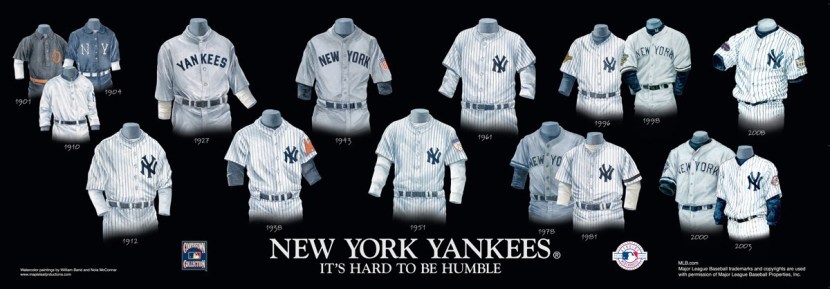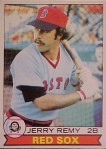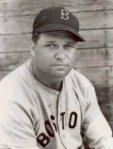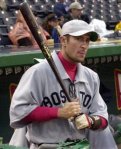Tagged: Retired Numbers
#24, RF, Dwight ‘Dewey’ Evans
Well, New Year’s usually signals a few things in the baseball universe. The Hot Stove Season is reaching its stretch run. The thought of Spring Trading begins to warm the soul. And perhaps more controversially, The Hall of Fame announcement is upon us.
Every year, we look to the BBWAA to give us a reason to cheer, p!ss and moan or just grit our teeth and throw up our hands with the whole damn process. After all, the guys you love don’t get their recognition, the guys you hate seem to ‘slide’ in and guys you just couldn’t care about grab some spotlight. But we’re used to it.
However, in the last few years, the landscape has changed. The Steroid Era has shed a new light upon players who for lack of ‘super’ stardom, media attention and just plain ‘average’ consistency were overlooked, passed-up or underappreciated for their efforts. Players such as Ron Santo (finally, but posthumously) have received their Veterans Committee due, while players like Keith Hernandez, Dwight Evans, Alan Trammell and Tim Raines have been on the outside looking in. With PED playboys like Big Mac, Sammy Sosa, Palmero and Jeff Bagwell (rightly or not, the shadow covers him) taking up space on the ballot, it let’s periphery guys like Don Mattingly, Dale Murphy, Lee Smith and Jack Morris get a little more time in the thought process over all. Unfortunately, Donnie Baseball and Murphy were superstars who produced consistently but for a shorter span of time (unfortunately, the beloved Luis Tiant may fall into this category) . Smith was a journeyman who, though possessing all the qualities of a big, menacing closer, seems to have been hurt by his many stops around the league and having no definitive ‘superstar moment’. Jack Morris… well, he’s a borderline a Hall of Famer. Yes, he won 20 plus games three times and played on World Series winning teams, catching media spotlight fire with the ’91 Twins & ’92 Jays for example, but he wasn’t the cog that ran the gears. 
Then there’s Edgar Martinez. Easily one of the better hitters of his era (amidst the Steroid Era) who may have more than one glaring mark against him. First, he played in Seattle (yes, so did Griffey Jr., A-Rod and Randy Johnson… but they left), not a media market or a perennial contender. Second, and most importantly, he played the majority of his career as a Designated Hitter. Oh, my error, the Designated Hitter. A standard set so high, the annual award for best DH in the AL is the Edgar Martinez Award. But, DH doesn’t count, it’s an imaginary position created by the Wizard of Oz (you know, a designated spot in the batting order to allow aging, over-the-hill superstars who couldn’t field a position some twilight time to earn a paycheck and pad the HOF stats) and doesn’t deserve consideration. They’re part timers. A pinch-hitter who gets off the bench four or five times a day. Who cares if he produces HOF numbers, right?
So, let’s take a look at one of the most under-appreciated members of the Boston Red Sox: Dwight Evans. (keep in mind these are his totals during his 19 year tenure with the Scarlett Hose. Dewey finished his career with a one year stint in Baltimore.)
- Games played: 2505 Rank: 2nd (1st: Yaz / 3rd Ted)
- Hits: 2373 Rank: 4th (3rd: Rice / 5th Boggs)
- Average: .272 Rank: Outside top 10 ( Yaz .285 / Doerr .288)
- RBI: 1346 Rank: 4th (3rd: Rice / 5th: Doerr)
- HR: 379 Rank: 4th (3rd: Rice / 5th: Ortiz*)
- Runs: 1435 Rank: 3rd (2nd: Ted / 5th: Rice)
- Base on Balls: 1337 Rank: 3rd (2nd: Yaz / 4th: Boggs)
- OPS: .842 Rank: Outside top 10 (Yaz has an .841 / Rice .854)
So, loo king at the numbers, we see obvious questions and answers to the argument. He is, for the most part, sandwiched between teammates who are enshrined in Cooperstown (Captain Carl, Jim Ed., Boggs) and legendary HOF’ers like Ted and Bobby Doerr. The second half of his career was statistically more productive than the first and was consistently so until his retirement. During years when players begin winding down, Dewey was in cruise control and producing at a steady clip.
king at the numbers, we see obvious questions and answers to the argument. He is, for the most part, sandwiched between teammates who are enshrined in Cooperstown (Captain Carl, Jim Ed., Boggs) and legendary HOF’ers like Ted and Bobby Doerr. The second half of his career was statistically more productive than the first and was consistently so until his retirement. During years when players begin winding down, Dewey was in cruise control and producing at a steady clip.
Was he overshadowed? An integral member of the 1975 team, he was a lesser star than Yaz, Tiant, Pudge, Lee and The Goldust Twins. After Lynn and Fisk went West, Tiant let go, Yaz retired and guys like Eck and Lansford come and gone, it was Dewey who came into his own offensively while continuing his defensive excellence. Again, superstars surrounded him. Rice, Hurst, Boggs Buckner and Clemens. Evans simply continued to perform.
During the 1980′s (the latter half of his MLB career which officially began in 1972) in his playing age years of 28 (1980) through age year 37 (1989):
- 3 times finished in the top 10 in the AL in Hits.
- 4 times finished in the top 10 in the AL in Doubles.
- 5 times finished in the top 10 in the AL in RBI.
- 5 times finished in the top 10 in the AL in HR, leading the league in 1981.
- 5 times finished in the top 10 in the AL in OPS% , leading the league twice.
- 6 times finished in the top 10 in the AL in Runs scored, leading the league in 1984.
- 7 times finished in the top 10 in the AL in Bases on Balls, leading the league three times.
Evans appeared on the AL MVP ballot 5 times (all in the 1980’s) with 4 times placing in the top 10. Finished 3rd over-all in 1981 behind winner Rollie Fingers and Ricky Henderson.
8 Gold Gloves. 3 All-Star Games. 2 Silver Sluggers.
His lifetime WAR (wins above replacement) is 61.8 (Mind you, this currently ranks 141st ALL TIME in MLB)
Looking at his basic stats or his Sabermetric stats place him in an above average category. Dwight was included on the BBWAA Hall of Fame ballot in 1997 (5.9%), 1998 (10.4%) and 1999 (3.6%) before dropping off due to insufficient support under the official rules of balloting (under 5% in a given year or reaching 15th year on ballot). His election, like that of Ron Santos’, would be a Veterans committee pick. Currently a member of the Red Sox Hall of Fame, Dwight’s number 24 (originally 40 as a rookie) is still in circulation.

Hall of Famer’s who wore Red Sox….
This installment of the investigative process will focus on members of the National Baseball Hall of Fame who have been members of the storied Scarlett Hose, obviously with a bit more focus on those who are enshrined with the ‘B’ on their cap.
members of the storied Scarlett Hose, obviously with a bit more focus on those who are enshrined with the ‘B’ on their cap.
So here is the over all list….
… Players listed in bold are enshrined with the Red Sox ‘B’ upon their cap.
| Player | Years played with the Red Sox |
|---|---|
| Luis Aparicio | 1971-73 |
| Wade Boggs | 1982-92 |
| Lou Boudreau | 1951-52 |
| Jesse Burkett | 1905 |
| Orlando Cepeda | 1973 |
| Jack Chesbro | 1909 |
| Jimmy Collins | 1901-07 |
| Joe Cronin
Andre Dawson |
1935-45
1993-94 |
| Bobby Doerr | 1937-44, 1946-51 |
| Dennis Eckersley | 1978-84, 1998 |
| Rick Ferrell | 1934-37 |
| Carlton Fisk | 1969, 1971-80 |
| Jimmie Foxx | 1936-42 |
| Lefty Grove | 1934-41 |
| Harry Hooper | 1909-20 |
| Waite Hoyt | 1919-20 |
| Fergie Jenkins | 1976-77 |
| George Kell | 1952-54 |
| Heinie Manush | 1936 |
| Juan Marichal | 1974 |
| Herb Pennock | 1915-22 |
| Tony Perez | 1980-82 |
| Jim Rice | 1974-89 |
| Red Ruffing | 1924-30 |
| Babe Ruth | 1914-19 |
| Tom Seaver | 1986 |
| Al Simmons | 1943 |
| Tris Speaker | 1907-15 |
| Dick Williams | 1963-64 |
| Ted Williams | 1939-42, 1946-60 |
| Carl Yastrzemski | 1961-83 |
| Cy Young | 1901-08 |
A few notes: Jimmy Collins does not have a cap in his HOF plaque, however the Hall lists his primary team as Boston. Andre Dawson was omitted from the official Red Sox listing of former Sox in the HOF, however I’m including him because he did in fact play there… I saw it, with my own eyes. Jimmie Foxx is enshrined wearing a Red Sox cap, however the Hall, and rightfully so, recognizes his primary team as the Philadelphia Athletics… the same can be said of Lefty Grove.
And here is the official recording of the retired numbers (excluding Jackie Robinson’s #42 retired by Major League Baseball for the simple fact he was not a member of the Boston Red Sox, even if historically he probably should have been)…
The retired Red Sox numbers, along with Jackie Robinson’s #42 that was retired by Major League Baseball in 1997, are posted on the right field facade in Fenway Park.
The Red Sox policy on retiring uniform numbers is based on the following criteria:
- Election to the National Baseball Hall of Fame
- At least 10 years played with the Red Sox
Bobby Doerr – #1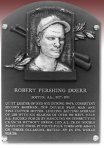
- Played 14 seasons in Majors, all with Red Sox (1937-44, 1946-51), before retiring due to a back injury.
- Elected to Baseball Hall of Fame in 1986.
- Tied for AL lead with Dom DiMaggio in triples in 1950 (11).
- Led AL in slugging percentage in 1944 (.528).
- Named The Sporting News AL Player of the Year in 1944.
- Hit .409 (9-22) in 1946 World Series to lead Red Sox.
Joe Cronin – #4
- First modern-day player to become a league president.
- Elected to Baseball Hall of Fame in 1956.
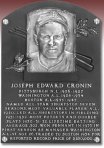
- Compiled .301 average in 20 MLB seasons.
- Affiliated with Red Sox for 24 seasons as player/manager, manager, and general manager.
- Leads all Red Sox managers with 1071 wins.
- Managed Red Sox to AL pennant in 1946.
- Holds AL record for pinch-hit homers in a season, 5 (1943).
- Became 1st player to hit pinch-hit homes in both games of a doubleheader, June 17, 1943 (in a stretch when he hit three three-run pinch-hit homers in four at-bats).
- Participated in 12 All-Star Games for AL, six as a player.
Johnny Pesky – #6
- Signed by the Red Sox in 1940.
- Officially associated with the Red Sox for 21 years as a player, coach, and manager.
- Compiled .307 average in 12 MLB seasons.
- Known as “Mr. Red Sox”.
Carl Yastrzemski – #8
- Named to the Baseball Hall of Fame in 1989.
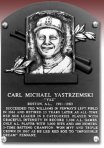
- Along with Johnny Bench became the 18th and 19th players elected to Hall of Fame on the first ballot.
- Received 95 percent of Hall of Fame voting, the seventh highest in the history of voting at that time.
- First Little League player to be elected to the Hall of Fame.
- Won AL Triple Crown in 1967.
- Most games lifetime in the AL with 3,308.
- AL MVP in 1967.
- Seven-time Gold Glove winner.
- Tied MLB record with 1.000 fielding percentage in 1977.
- Selected Outstanding Player of 1970 All-Star Game.
- Played 167 consecutive errorless games.
- Only AL player with 400 home runs and 3,000 hits.
Ted Williams – #9
- Named to starting outfield of Greatest Living Team, 1969.
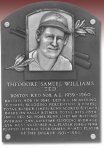
- Named MLB Player of Decade for 1950s.
- Elected to Baseball Hall of Fame in 1966.
- AL MVP in 1946, 49.
- Won AL Triple Crown in 1942, 47.
- Led AL in batting six times.
- Led AL in home runs four times.
- Led AL in total bases five times.
- Led AL in walks eight times.
- Led AL in slugging percentage nine times.
- Holds MLB record for most successive times reaching base safely, 16, in Sept. 1957 (2 singles, 4 HR, 9 BB, 1 HBP).
- Oldest MLB player to win batting title, batting .388 in 1957 at age 39.
- Won batting title again in 1958 at age 40.
- Voted Greatest Red Sox Player of all time by fans, 1969 and 1982.
- Holds MLB rookie records for most walks (107) and RBIs (145).
- Holds Red Sox record with 17 grand slams.
Jim Rice – #14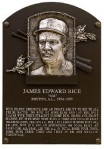
- Debuted August 19, 1974.
- Named AL Silver Slugger in 1984 and 1985.
- Named AL MVP in 1978.
- Named to eight All-Star teams.
- Led AL with hits (213) in 1978.
- Led AL in home runs in 1977 (39), 1978 (46), and 1983 (39).
- Elected to Baseball Hall of Fame in 2009.
Carlton Fisk – #27
- Carlton Fisk will always be remembered as the player who hit the historic, 12th-inning, game-winning homer in
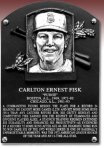 Fenway Park off Reds pitcher Pat Darcy in Game 6 of the 1975 World Series. Besides being the hero on MLB’s biggest stage in a game that has been referred to as “the greatest World Series game ever played,” Fisk had many other memorable highlights during his 11-year career as a member of the Red Sox.
Fenway Park off Reds pitcher Pat Darcy in Game 6 of the 1975 World Series. Besides being the hero on MLB’s biggest stage in a game that has been referred to as “the greatest World Series game ever played,” Fisk had many other memorable highlights during his 11-year career as a member of the Red Sox. - Red Sox first draft choice and fourth overall selection in the January 1967 Winter Baseball Amateur Draft.
- Made his MLB debut on September 18, 1969.
- Was the first unanimous winner of the American League Rookie of the Year Award in 1972 (.293, 22 HR, 61 RBIs). He was also tied for the AL lead with nine triples.
- Won the 1972 AL Gold Glove Award for defensive excellence.
- Seven-time All-Star, including four games started. He was voted as a starter five times but was replaced in 1974 due to a knee injury.
- Was the AL Honorary All-Star Game captain on July 13, 1999 at Fenway Park.
- Is the all-time Red Sox leader in games caught with 990.
- Red Sox Hall of Fame Inductee on September 8, 1997.
Now obviously, Johnny Pesky is the only member of Retired Row who is not a member of the Hall but was retired due to his decades of service to the Olde Towne Team… and rightfully so, however that does leave the ‘door open’ so to speak for other players and a whole sh!tload of “Why not him..”, “He should be..” so on and so forth. And with a few of the omitted Hall of Famer’s not on Retired Row, they may just have a case…. but I’ve covered this very argument in earlier editions of this same blog and this particular entry is not for that reason….
So let’s recap. The Boston Red Sox Hall of Fame. The All-Time Red Sox leaders in statistics. The National Baseball Hall of Fame. Retired Row.
The basics are set.
Ted and Yaz were the only real givens.
Now we get to the difficult part. Who gets added to the list and where do they get placed? Should it be a ‘Top 5’ or a ‘Top 10’? Aside from a minimum number of at bats or appearances, what qualifications should allow for a player to be named ‘Top’ or ‘Best of’ for the Red Sox? Championships are certainly out the door otherwise we’d have to disqualify one of the Greatest Players to Never Win a Title in Williams, and that renders pennants useless as well. If we go just on statistics, it may give an advantage to players who climbed the numbers ladder due to longevity and not superb ability.. but if they didn’t have the ability, one would think they never would have had the longevity.
Rice. Clemens. Evans. The Million Dollar Outfield of Speaker, Hooper and Lewis. Ortiz. Ruth. Vaughn. The Teammates of DiMaggio, Pesky and Doerr. Lynn. Pedroia. Collins. Schilling. Young. Foxx. Tiant. Garciaparra. Varitek. Boggs. Wakefield. Cronin. Grove. Youkilis. Fisk… to name a few.
Decisions, decisions.
A Brief History…
With all this talk of Retired numbers, Honored numbers and such… how about a brief lesson on the history of baseball’s uniforms with a thanks to Wikipedia.
A baseball uniform is a type of uniform worn by baseball players, and by some non-playing personnel, such as field managers and coaches. It is worn to indicate the person’s role in the game and — through the use of logos, colors, and numbers — to identify the teams and their players, managers, and coaches.
The New York Knickerbockers were the first baseball team to use uniforms, taking the field on April 4, 1849, in pants made of blue wool, white flannel shirts (jerseys) and straw hats. The practice of wearing a uniform soon spread, and by 1900, all major league teams had adopted them. By 1882, most uniforms included stockings, which covered the leg from foot to knee, and had different colors that reflected the different baseball positions. In the late 1880s, the Detroit Wolverines and Washington Nationals of the National League and the Brooklyn Bridegrooms of the American Association were the first to wear striped uniforms.
Caps, or other types of headgear with eyeshades, have been a part of baseball uniforms from the beginning. Baseball teams often wore full-brimmed straw hats or no cap at all since there was no official rule regarding headgear. Completing the baseball uniform are cleats and stockings, both of which have also been around for a long time.
By the end of the 19th century, teams began the practice of having two different uniforms, one for when they played at home in their own baseball stadium and a different one for when they played away (on the road) at the other tea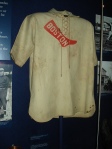 m’s ballpark. It became common to wear white pants with a white color vest at home and gray pants with a gray or solid color vest when away. Most modern teams also have one or more alternate uniforms, usually consisting of the primary or secondary team color on the vest instead of the usual white or gray. Teams on occasion will also wear throwback uniforms.
m’s ballpark. It became common to wear white pants with a white color vest at home and gray pants with a gray or solid color vest when away. Most modern teams also have one or more alternate uniforms, usually consisting of the primary or secondary team color on the vest instead of the usual white or gray. Teams on occasion will also wear throwback uniforms.
Traditionally home uniforms have displayed the team name on the front, while away uniforms have displayed the name of the city (or state) that the team is from. There are many exceptions to that rule, however.
The earliest photographic evidence of the use of uniform numbers comes from a 1909 Chicago Daily News picture of pitching great José Mendez. In the photograph, Mendez is seen in his Cuban Stars uniform with a number “12” on his left sleeve. Inspired by hockey’s and football’s use of uniform numbers, the Cleveland Indians became the first big league club to experiment with numbered uniforms when they took the field at League Park in Cleveland, on June 26, 1916, donning large numerals on their left sleeves. The experiment lasted just a few weeks that season and, after a brief trial the following year, was abandoned altogether.
The first MLB game to have both teams wear numbers on their jerseys was Indians vs Yankees May 13, 1929.
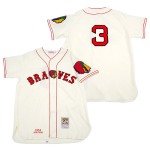 While some players will wear several numbers throughout their careers as they move from team to team, others have become so attached to a specific number for some reason (including superstition), that try to acquire it as they join a new club.
While some players will wear several numbers throughout their careers as they move from team to team, others have become so attached to a specific number for some reason (including superstition), that try to acquire it as they join a new club.
In some cases, the number is available on a player’s new club. Other times, the number will already be in use by another member of that team (or sometimes retired). When this occurs, the player will occasionally ask the other player to change numbers, in order to surrender that number to the newcomer. Some players holding a number in such a case will voluntarily make such a change, while others may need to be “bribed” in order to do so. For example, when Rickey Henderson was traded to the Blue Jays in 1993, he paid new teammate Turner Ward $25,000 for the #24 that Henderson had worn throughout much of his career, and that Ward had been wearing at the time. In contrast, when Mitch Williams joined the Phillies in 1991, he acquired his old #28 from John Kruk in exchange for $10 and two cases of beer.
Some players, who are unable to get the number they had on their previous team, will obtain a number close in succession. For example, Roger Clemens wore #21 during the first 15 years of his career with the Red Sox and Blue Jays, and during his college days at Texas. Upon Clemens’ arrival in New York, he reportedly asked long-time Yankee outfielder Paul O’Neill to surrender his #21, but O’Neill refused. Though he would eventually opt for #22, Clemens initially reversed his beloved #21, and wore #12. Clemens continued to wear #22 upon signing with his hometown Houston Astros in 2004 and, upon resigning with the Yankees, Robinson Canó, owner of #22 at the beginning of the 2007 season, moved to #24 in anticipation of the Yankees possibly re-signing Clemens, leaving #22 available for Clemens.
in succession. For example, Roger Clemens wore #21 during the first 15 years of his career with the Red Sox and Blue Jays, and during his college days at Texas. Upon Clemens’ arrival in New York, he reportedly asked long-time Yankee outfielder Paul O’Neill to surrender his #21, but O’Neill refused. Though he would eventually opt for #22, Clemens initially reversed his beloved #21, and wore #12. Clemens continued to wear #22 upon signing with his hometown Houston Astros in 2004 and, upon resigning with the Yankees, Robinson Canó, owner of #22 at the beginning of the 2007 season, moved to #24 in anticipation of the Yankees possibly re-signing Clemens, leaving #22 available for Clemens.
In their first career games, Cincinnati Reds outfielder Eric Davis and White Sox pitcher Joe Horlen did not have jersey numbers.
Detroit Tigers center fielder Gabe Kapler also played a game with a blank jersey, though it that case the Tigers were playing the final game at Tiger Stadium and the players were honoring the famous Tigers in each position. In Kapler’s case he was honoring Ty Cobb, whose career pre-dated uniform numbers.
 A team will sometimes retire a uniform number so that future players and coaches cannot wear those numbers with that team. Only the player with the retired number can wear that number if he returns to that team as a player or coach. The first Major League Baseball player to have his number retired was Lou Gehrig (#4). #4 and #5 have each been retired by 8 teams, more than any other number. The Yankees have retired a total of 16 numbers, more than any other team. The highest player uniform number to be retired was Carlton Fisk’s #72, but the Cardinals retired #85 in honor of their one-time owner August Busch, Jr.. Though he never wore a unifor
A team will sometimes retire a uniform number so that future players and coaches cannot wear those numbers with that team. Only the player with the retired number can wear that number if he returns to that team as a player or coach. The first Major League Baseball player to have his number retired was Lou Gehrig (#4). #4 and #5 have each been retired by 8 teams, more than any other number. The Yankees have retired a total of 16 numbers, more than any other team. The highest player uniform number to be retired was Carlton Fisk’s #72, but the Cardinals retired #85 in honor of their one-time owner August Busch, Jr.. Though he never wore a unifor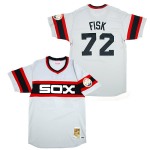 m, that is how old he was at the time of the honor. The Cleveland Indians retired the #455 in 2001 in honor of “the fans”, to commemorate the then-longest home sellout streak ever (although MLB does not allow any team to issue three-digit uniform numbers).
m, that is how old he was at the time of the honor. The Cleveland Indians retired the #455 in 2001 in honor of “the fans”, to commemorate the then-longest home sellout streak ever (although MLB does not allow any team to issue three-digit uniform numbers).
Eight players and one manager, Casey Stengel, have had their numbers retired with more than one team. Nolan Ryan had two different numbers (#30 and #34) retired between three different teams. Fisk’s #27 from the Red Sox and #72 from the White Sox are both retired, as are Reggie Jackson’s #9 and #44, respectively by the A’s and Yankees.
The Toronto Blue Jays do not retire numbers, but rather have an alternative method of honoring their players called the ‘Level of Excellence’.
 In 1997, Major League Baseball, for the first time ever, made a Major League-wide retirement of a number, when #42 could not be issued to any new players, having been retired in honor of Jackie Robinson, although all players who currently wore the number upon the mass retirement of #42, such as Mo Vaughn and Butch Huskey of the Red Sox and Mets, were allowed to keep it under a grandfather clause if they were wearing the number in honor of Jackie Robinson. The only player who still wears #42 is Mariano Rivera of the New York Yankees. The Los Angeles Dodgers, for whom Robinson played (as a Brooklyn Dodger), had already retired the number in 1972 after Robinson’s death.
In 1997, Major League Baseball, for the first time ever, made a Major League-wide retirement of a number, when #42 could not be issued to any new players, having been retired in honor of Jackie Robinson, although all players who currently wore the number upon the mass retirement of #42, such as Mo Vaughn and Butch Huskey of the Red Sox and Mets, were allowed to keep it under a grandfather clause if they were wearing the number in honor of Jackie Robinson. The only player who still wears #42 is Mariano Rivera of the New York Yankees. The Los Angeles Dodgers, for whom Robinson played (as a Brooklyn Dodger), had already retired the number in 1972 after Robinson’s death.
However, the #42 would be worn by a number of players other than Rivera in 2007, which marked the 60th anniversary of Robinson’s first appearance in Major League Baseball (the event that broke the sport’s 20th-century color line). Before the season, then-Cincinnati Reds outfielder Ken Griffey, Jr. asked Robinson’s widow, Rachel Robinson, and MLB Commissioner Bud Selig for permission to wear #42 on April 15, the anniversary date of Robinson’s historic game. Both gave their approval, and Selig later ruled that any player who wished to wear #42 on that date could do so.
Honored Numbers… honorable mention…
A few more former members of the Boston Americans who made an impact while in Scarlett Hose for consideration. Again, they’re members of the Red Sox Hall of Fame and on the Bubble.
And yes, there just might be yet another controversial pick….
 Bill Lee, nicknamed “Spaceman”, played for the Boston Red Sox from 1969-1978 and on November 7, 2008, Lee was inducted into the Red Sox Hall of Fame as the team’s record-holder for most games pitched by a left-hander (321) and the third-highest win total (94) by a Red Sox southpaw. In addition to his baseball experience, Lee is known for his adherence to counterculture behavior, his antics both on and off the field, and his use of the Leephus pitch, a personalized variation of the eephus pitch. Lacking a good fastball, Lee developed off-speed pitches, including a variation of the Eephus pitch. The Leephus pitch or Space Ball, the names for Lee’s take on the eephus pitch, follows a high, arcing trajectory and is very slow. Lee was used almost exclusively as a relief pitcher during the first four years of his career. During that period, Lee appeared in 125 games, starting in nine, and compiled a 19-11 record. In 1973, he was used primarily as a starting pitcher. He started 33 of the 38 games in which he appeared and went 17-11 with a 2.95 Earned Run Average, and was named to the American League All-Star team. He followed 1973 with two more 17-win seasons. He started two games in the 1975 World Series against the Cincinnati Reds. His first start came in Game 2 of the series which the Reds won 3-2. In Game 7, Lee shut out the Reds for five innings and the Red Sox took a 3-0 lead. Lee left with a blister and the Red Sox lost the game by a score of 4-3, and the 1975 World Series four games to three. During the 1978 season, Lee and Red Sox manager Don Zimmer engaged in an ongoing public feud over the handling of the pitching staff. Lee’s countercultural attitude and lack of respect for authority clashed with Zimmer’s old-school, conservative personality. Lee and a few other of the more anti-authority Red Sox formed what they called “The Buffalo Heads” as a response to the manager. Zimmer retaliated during the season by relegating Lee to the bullpen and convincing management to trade away some of them, including Hall of Famer Fergie Jenkins and Bernie Carbo. Jersey #37
Bill Lee, nicknamed “Spaceman”, played for the Boston Red Sox from 1969-1978 and on November 7, 2008, Lee was inducted into the Red Sox Hall of Fame as the team’s record-holder for most games pitched by a left-hander (321) and the third-highest win total (94) by a Red Sox southpaw. In addition to his baseball experience, Lee is known for his adherence to counterculture behavior, his antics both on and off the field, and his use of the Leephus pitch, a personalized variation of the eephus pitch. Lacking a good fastball, Lee developed off-speed pitches, including a variation of the Eephus pitch. The Leephus pitch or Space Ball, the names for Lee’s take on the eephus pitch, follows a high, arcing trajectory and is very slow. Lee was used almost exclusively as a relief pitcher during the first four years of his career. During that period, Lee appeared in 125 games, starting in nine, and compiled a 19-11 record. In 1973, he was used primarily as a starting pitcher. He started 33 of the 38 games in which he appeared and went 17-11 with a 2.95 Earned Run Average, and was named to the American League All-Star team. He followed 1973 with two more 17-win seasons. He started two games in the 1975 World Series against the Cincinnati Reds. His first start came in Game 2 of the series which the Reds won 3-2. In Game 7, Lee shut out the Reds for five innings and the Red Sox took a 3-0 lead. Lee left with a blister and the Red Sox lost the game by a score of 4-3, and the 1975 World Series four games to three. During the 1978 season, Lee and Red Sox manager Don Zimmer engaged in an ongoing public feud over the handling of the pitching staff. Lee’s countercultural attitude and lack of respect for authority clashed with Zimmer’s old-school, conservative personality. Lee and a few other of the more anti-authority Red Sox formed what they called “The Buffalo Heads” as a response to the manager. Zimmer retaliated during the season by relegating Lee to the bullpen and convincing management to trade away some of them, including Hall of Famer Fergie Jenkins and Bernie Carbo. Jersey #37
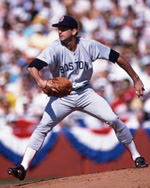 Bruce Hurst and Roger Clemens will forever be remembered as one of the best one-two punches in the Red Sox history. Hurst was a specialist at changing speeds. Consistently good but never overpowering hitters, his fastball was hard enough to get in on right-handed hitters, and he mixed it with an excellent curve and a slider as well. He also had a decent forkball at times. Thanks to his great control, Hurst was able to work corners well and had a profuse knowledge of each hitter. He won 88 games for the Red Sox in a span of nine years, posting his best season in 1988 with an 18-6 record. In 1986, despite spending six midsummer weeks on the disabled list with a pulled groin, Hurst posted a 2.99 ERA with 13 victories and helped lead the Red Sox to the 1986 World Series against the New York Mets. He won Game 1 1-0 and Game 5 4-2 to give Boston a 3-2 lead in the Series. The score in Game 6 stood at 3-3 after nine innings. The Red Sox scored in the top of the tenth on a home run by Dave Henderson, then added an insurance run. With nobody on and two outs in the bottom of the tenth, the Shea Stadium scoreboard was all set to display “Congratulations Boston Red Sox, 1986 World Champions”, with Hurst being selected as the World Series Most Valuable Player. Suddenly, the Mets rallied to win the game with three runs, forcing decisive Game 7. With three days rest, Hurst had given up only three singles through six innings and left the game tied 3-3. The rest is history, with the Mets winning the World Championship. Believers of “The Curse of the Bambino” have pointed out the letters in the name BRUCE HURST can be re-arranged as B RUTH CURSE. Jersey #47
Bruce Hurst and Roger Clemens will forever be remembered as one of the best one-two punches in the Red Sox history. Hurst was a specialist at changing speeds. Consistently good but never overpowering hitters, his fastball was hard enough to get in on right-handed hitters, and he mixed it with an excellent curve and a slider as well. He also had a decent forkball at times. Thanks to his great control, Hurst was able to work corners well and had a profuse knowledge of each hitter. He won 88 games for the Red Sox in a span of nine years, posting his best season in 1988 with an 18-6 record. In 1986, despite spending six midsummer weeks on the disabled list with a pulled groin, Hurst posted a 2.99 ERA with 13 victories and helped lead the Red Sox to the 1986 World Series against the New York Mets. He won Game 1 1-0 and Game 5 4-2 to give Boston a 3-2 lead in the Series. The score in Game 6 stood at 3-3 after nine innings. The Red Sox scored in the top of the tenth on a home run by Dave Henderson, then added an insurance run. With nobody on and two outs in the bottom of the tenth, the Shea Stadium scoreboard was all set to display “Congratulations Boston Red Sox, 1986 World Champions”, with Hurst being selected as the World Series Most Valuable Player. Suddenly, the Mets rallied to win the game with three runs, forcing decisive Game 7. With three days rest, Hurst had given up only three singles through six innings and left the game tied 3-3. The rest is history, with the Mets winning the World Championship. Believers of “The Curse of the Bambino” have pointed out the letters in the name BRUCE HURST can be re-arranged as B RUTH CURSE. Jersey #47
Jerry Remy was traded to the Boston Red Sox after the 1977 season and continued as the Red Sox starter at second in 1978, being selected to play in the All-Star Game, in which he did not appear. He continued as their starting second basemen for the next six seasons, although he was often hampered by injuries. Bill James, in his Historical Abstract rated him as the 100th greatest second baseman of all time as of 2002. Since 1988, Remy has found success in broadcasting, working for the New England Sports Network (NESN), as the color commentator for all NESN Red Sox broadcasts. Since 2001, Remy has been teamed with play-by-play announcer Don Orsillo. NESN celebrated Jerry Remy Day on June 24, 2008, in honor of Remy’s 20 years of service for the network. He is currently serving as the first president of Red Sox Nation. Jerry Remy was inducted into the Boston Red Sox Hall of Fame in 2006. Jersey #2
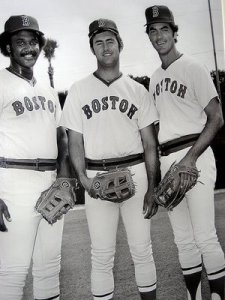 Fred Lynn, after graduation from USC, started his career for the Red Sox with a phenomenal 1975 season in which he won the Most Valuable Player and Rookie of the Year awards, the first player ever to win both in the same season. (The feat has since been duplicated by Seattle Mariners right fielder Ichiro Suzuki in 2001.) Lynn and fellow rookie outfielder Jim Rice were dubbed as the “Gold Dust Twins” because of their combined baseball talents. In 1975, Lynn led the American League in doubles, runs scored and slugging percentage, finished second in the batting race with a .331 average, and won a Gold Glove Award for his defensive play. On June 18 he bombed the Tigers with 3 HR, 10 RBI, and 16 total bases in one game. Unfortunately, Lynn found it difficult to duplicate the extraordinary success of his first season, and was hampered by injuries. These sometimes were caused by fearless play, such as a broken rib caused by crashing into an outfield wall, or knee injuries from breaking up double plays, but most were simply of the nagging variety, such as strains and sprains. Although he didn’t maintain the same level of his rookie season, he still excelled, winning three more Gold Gloves in 1978-80 and finishing 4th in the 1979 MVP voting, while being elected to the All-Star team every year with the Red Sox. Jersey #19.
Fred Lynn, after graduation from USC, started his career for the Red Sox with a phenomenal 1975 season in which he won the Most Valuable Player and Rookie of the Year awards, the first player ever to win both in the same season. (The feat has since been duplicated by Seattle Mariners right fielder Ichiro Suzuki in 2001.) Lynn and fellow rookie outfielder Jim Rice were dubbed as the “Gold Dust Twins” because of their combined baseball talents. In 1975, Lynn led the American League in doubles, runs scored and slugging percentage, finished second in the batting race with a .331 average, and won a Gold Glove Award for his defensive play. On June 18 he bombed the Tigers with 3 HR, 10 RBI, and 16 total bases in one game. Unfortunately, Lynn found it difficult to duplicate the extraordinary success of his first season, and was hampered by injuries. These sometimes were caused by fearless play, such as a broken rib caused by crashing into an outfield wall, or knee injuries from breaking up double plays, but most were simply of the nagging variety, such as strains and sprains. Although he didn’t maintain the same level of his rookie season, he still excelled, winning three more Gold Gloves in 1978-80 and finishing 4th in the 1979 MVP voting, while being elected to the All-Star team every year with the Red Sox. Jersey #19.
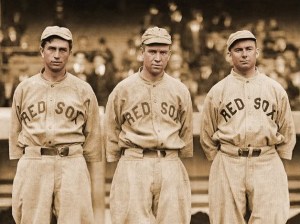 Harry Hooper, Tris Speaker and Duffy Lewis, nicknamed “The Million Dollar Outfield“. In 1910 the Red Sox signed Duffy Lewis, who became the left fielder, and, with Speaker and Harry Hooper would form Boston’s “Million-Dollar Outfield”, one of the finest outfield trios in baseball history, playing together until Speaker was traded to the Cleveland Indians in 1916. Harry Hooper, who batted left-handed and threw right-handed, broke into the majors with the Red Sox in 1909, and still holds many of the team’s records. He was traded to the Chicago White Sox in the 1921 season and finished his career in 1925. On May 30, 1913 Hooper became the first player to hit a home run to lead off both games of a doubleheader, a mark only matched by Rickey Henderson 80 years later. Beside this, Hooper is the only person to be a part of four Red Sox World Series championships: in 1912, 1915, 1916 and 1918. On October 13, 1915, he became the first player to hit two home runs in a single World Series game. Hooper was also the captain of the Red Sox in 1919. Tris Speaker, considered one of the best offensive and defensive center fielders in the history of Major League Baseball, compiled a career batting average of .345 (fourth all-time), and still holds the record of 792 career doubles. Defensively, his career records for assists, double plays, and unassisted double plays by an outfielder still stand as well. His fielding glove was known as the place “where triples go to die.” Speaker helped lead the Boston Red Sox to two World Series championships. As a manager (for Cleveland) his innovations, most notably the platoon system and the infield rotation play, revolutionized the game. He was inducted into the Baseball Hall of Fame in its second year of voting, 1937. Duffy Lewis won three World Series championships with the Red Sox (1912, 1915, 1916) and is considered perhaps one of the best ever in fielding skill. At bat, Lewis was a renowned line-drive hitter who consistently finished in the top ten in most offensive categories despite a short career which was interrupted by World War I.
Harry Hooper, Tris Speaker and Duffy Lewis, nicknamed “The Million Dollar Outfield“. In 1910 the Red Sox signed Duffy Lewis, who became the left fielder, and, with Speaker and Harry Hooper would form Boston’s “Million-Dollar Outfield”, one of the finest outfield trios in baseball history, playing together until Speaker was traded to the Cleveland Indians in 1916. Harry Hooper, who batted left-handed and threw right-handed, broke into the majors with the Red Sox in 1909, and still holds many of the team’s records. He was traded to the Chicago White Sox in the 1921 season and finished his career in 1925. On May 30, 1913 Hooper became the first player to hit a home run to lead off both games of a doubleheader, a mark only matched by Rickey Henderson 80 years later. Beside this, Hooper is the only person to be a part of four Red Sox World Series championships: in 1912, 1915, 1916 and 1918. On October 13, 1915, he became the first player to hit two home runs in a single World Series game. Hooper was also the captain of the Red Sox in 1919. Tris Speaker, considered one of the best offensive and defensive center fielders in the history of Major League Baseball, compiled a career batting average of .345 (fourth all-time), and still holds the record of 792 career doubles. Defensively, his career records for assists, double plays, and unassisted double plays by an outfielder still stand as well. His fielding glove was known as the place “where triples go to die.” Speaker helped lead the Boston Red Sox to two World Series championships. As a manager (for Cleveland) his innovations, most notably the platoon system and the infield rotation play, revolutionized the game. He was inducted into the Baseball Hall of Fame in its second year of voting, 1937. Duffy Lewis won three World Series championships with the Red Sox (1912, 1915, 1916) and is considered perhaps one of the best ever in fielding skill. At bat, Lewis was a renowned line-drive hitter who consistently finished in the top ten in most offensive categories despite a short career which was interrupted by World War I.
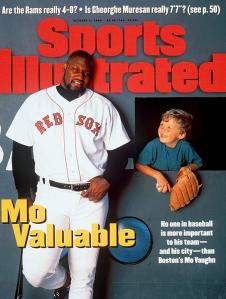 Mo Vaughn became the center of the Red Sox’s line-up in 1993, hitting 29 home runs and contributing 101 RBIs. In 1995, he established a reputation as one of the most feared hitters in the American League when he hit 39 home runs with 126 RBIs and a .300 average. He also garnered 11 stolen bases. His efforts, which led the Red Sox to the playoffs (only to lose to the Cleveland Indians in the American League Division Series), were rewarded with the American League MVP award. Vaughn had his career year with the Red Sox in 1996, batting an average of .326, playing in 161 games, with 44 home runs, and 143 RBIs. On May 30, 1997 playing a game against the Yankees, Vaughn went 4-for-4 with three solo homers in the Red Sox’s 10-4 win over the Yankees. Vaughn continued to improve over the next several seasons, batting .315 or higher from 1996 to 1998 and averaging 40 home runs and 118 RBIs. The Red Sox lost in the American League Division Series in 1998, once again to the Cleveland Indians, although Vaughn played well, hitting two home runs and driving in seven runs in game one. Vaughn formed a formidable middle of the lineup with shortstop Nomar Garciaparra. The two combined for 75 home runs in 1998, Vaughn’s final year with the club. He was noted for “crowding the plate”; his stance was such that his front elbow often appeared to be hovering in the strike zone, which intimidated pitchers into throwing wide and outside. Jersey # 42
Mo Vaughn became the center of the Red Sox’s line-up in 1993, hitting 29 home runs and contributing 101 RBIs. In 1995, he established a reputation as one of the most feared hitters in the American League when he hit 39 home runs with 126 RBIs and a .300 average. He also garnered 11 stolen bases. His efforts, which led the Red Sox to the playoffs (only to lose to the Cleveland Indians in the American League Division Series), were rewarded with the American League MVP award. Vaughn had his career year with the Red Sox in 1996, batting an average of .326, playing in 161 games, with 44 home runs, and 143 RBIs. On May 30, 1997 playing a game against the Yankees, Vaughn went 4-for-4 with three solo homers in the Red Sox’s 10-4 win over the Yankees. Vaughn continued to improve over the next several seasons, batting .315 or higher from 1996 to 1998 and averaging 40 home runs and 118 RBIs. The Red Sox lost in the American League Division Series in 1998, once again to the Cleveland Indians, although Vaughn played well, hitting two home runs and driving in seven runs in game one. Vaughn formed a formidable middle of the lineup with shortstop Nomar Garciaparra. The two combined for 75 home runs in 1998, Vaughn’s final year with the club. He was noted for “crowding the plate”; his stance was such that his front elbow often appeared to be hovering in the strike zone, which intimidated pitchers into throwing wide and outside. Jersey # 42
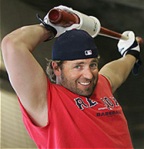 Kevin Millar played for the Marlins between 1998 and 2002, and was later sold to the Japanese Central League Chunichi Dragons. In order for the transaction to be completed, he first had to clear the waivers requested by the Marlins, but the Red Sox broke an “unwritten rule” and blocked the deal with a waiver claim. In an unprecedented deal brokered by MLB, the Marlins later repaid the money that the Dragons had paid for Millar, and the Sox also paid a similar sum to the Marlins in return for Millar. He became a clubhouse favorite and a sort of cult hero for the Red Sox fans because of his iconic “Cowboy Up” rallying cry. His clubhouse presence and offensive production helped spark the Red Sox to the 2003 American League Championship Series and the 2004 World Series. Millar was active in team interviews and conversations throughout the playoffs. He was often outspoken and made friends with many teammates. During the 2003 playoffs, Millar came up with the phrase “Cowboy Up,” and in 2004 referred to his team as “idiots” to keep his teammates loose during the stretch run to the World Series Championship. Probably one of his most memorable quotes came during the 2004 American League Championship Series when, while warming up before Game 4, with the Red Sox down 3 games to 0 against the arch-rival New York Yankees, he kept repeating “Don’t let us win tonight!” Further developing on that quote, he added “This is a big game. They’ve got to win because if we win we’ve got Petie coming back today and then Schilling will pitch Game 6 and then you can take that fraud stuff and put it to bed. Don’t let the Sox win this game.” These words became prophetic as the Sox rallied in 12 innings in game 4 to win 6-4 and went on to come from behind and win the ALCS 4 games to 3, capping off the biggest comeback in MLB playoff history and setting the stage to bring about death to the Curse of the Bambino. Jersey # 15
Kevin Millar played for the Marlins between 1998 and 2002, and was later sold to the Japanese Central League Chunichi Dragons. In order for the transaction to be completed, he first had to clear the waivers requested by the Marlins, but the Red Sox broke an “unwritten rule” and blocked the deal with a waiver claim. In an unprecedented deal brokered by MLB, the Marlins later repaid the money that the Dragons had paid for Millar, and the Sox also paid a similar sum to the Marlins in return for Millar. He became a clubhouse favorite and a sort of cult hero for the Red Sox fans because of his iconic “Cowboy Up” rallying cry. His clubhouse presence and offensive production helped spark the Red Sox to the 2003 American League Championship Series and the 2004 World Series. Millar was active in team interviews and conversations throughout the playoffs. He was often outspoken and made friends with many teammates. During the 2003 playoffs, Millar came up with the phrase “Cowboy Up,” and in 2004 referred to his team as “idiots” to keep his teammates loose during the stretch run to the World Series Championship. Probably one of his most memorable quotes came during the 2004 American League Championship Series when, while warming up before Game 4, with the Red Sox down 3 games to 0 against the arch-rival New York Yankees, he kept repeating “Don’t let us win tonight!” Further developing on that quote, he added “This is a big game. They’ve got to win because if we win we’ve got Petie coming back today and then Schilling will pitch Game 6 and then you can take that fraud stuff and put it to bed. Don’t let the Sox win this game.” These words became prophetic as the Sox rallied in 12 innings in game 4 to win 6-4 and went on to come from behind and win the ALCS 4 games to 3, capping off the biggest comeback in MLB playoff history and setting the stage to bring about death to the Curse of the Bambino. Jersey # 15
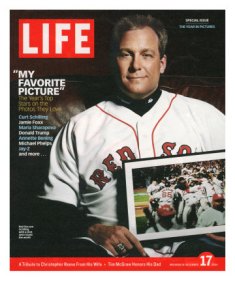 Curt Schilling began his professional career in the Red Sox farm system as a second-round pick in what would be the final January draft in MLB. He began his professional career with the Elmira Pioneers, a then Red Sox affiliate. After two and a half years in the minor leagues, he and Brady Anderson were traded to the Baltimore Orioles in 1988 for Mike Boddicker. In November 2003, the Diamondbacks traded Schilling to the Boston Red Sox. The trade to Boston reunited Schilling with Terry Francona, his manager during his final four years with the Philadelphia Phillies. This move meant Schilling and Francona have been part of the rivalries of both New York City baseball teams, though neither were on the New York side (New York Yankees vs. Boston Red Sox and New York Mets vs. Philadelphia Phillies).
Curt Schilling began his professional career in the Red Sox farm system as a second-round pick in what would be the final January draft in MLB. He began his professional career with the Elmira Pioneers, a then Red Sox affiliate. After two and a half years in the minor leagues, he and Brady Anderson were traded to the Baltimore Orioles in 1988 for Mike Boddicker. In November 2003, the Diamondbacks traded Schilling to the Boston Red Sox. The trade to Boston reunited Schilling with Terry Francona, his manager during his final four years with the Philadelphia Phillies. This move meant Schilling and Francona have been part of the rivalries of both New York City baseball teams, though neither were on the New York side (New York Yankees vs. Boston Red Sox and New York Mets vs. Philadelphia Phillies).
On September 16, 2004, Schilling won his 20th game of the 2004 for the Red Sox, becoming the fifth Boston pitcher to win 20 or more games in his first season with the team, and the first since Hall of Famer Dennis Eckersley in 1978. Schilling ended his regular season with a 21–6 record. On October 19, 2004, Schilling won Game 6 of the 2004 American League Championship Series against the New York Yankees. Notably, he won this game playing on an injured ankle—the same injuries that contributed to his disastrous outing in Game 1 of the ALCS. These injuries were so acute that by the end of his performance that day his white sock was soaked with blood, which is now referred to as “the bloody sock”. The win forced a Game 7, making the Red Sox the first team in MLB history to come back from a three-games-to-none deficit. The Red Sox would go on to win Game 7 and the ALCS and make their first World Series appearance since 1986. Schilling pitched (and won) Game 2 of the 2004 World Series for the Red Sox against the St. Louis Cardinals. In both series, he had to have the tendon in his right ankle stabilized repeatedly, in what has become known as the Schilling Tendon Procedure, after the tendon sheath was torn during his Game 1 ALDS appearance against the Los Angeles Angels. As in Game 6 of the ALCS, Schilling’s sock was soaked with blood from the sutures used in this medical procedure, but he still managed to pitch seven strong innings, giving up one run on four hits and striking out four. This second bloody sock was placed in the Baseball Hall of Fame after Boston’s victory over St. Louis in the World Series. A four-game sweep of the World Series erased the Curse of the Bambino. Schilling was once again runner-up in Cy Young voting in 2004, this time to Minnesota Twins hurler Johan Santana, who was a unanimous selection, receiving all 28 first-place votes. Schilling received 27 of the 28 second-place votes. Later, the entire Red Sox team was named Sports Illustrated’s 2004 Sportsmen of the Year, making Schilling only the second person to have won or shared that award twice.
In 2006 he began the season 4–0 with a 1.61 ERA. He finished the year with a 15–7 record and 198 strikeouts, with a respectable 3.97 ERA. On May 27, he earned his 200th career win, the 104th major league pitcher to accomplish the feat.On August 30, Schilling collected his 3,000th strikeout. Schilling has the highest ratio of strikeouts to walks of any pitcher with at least 3,000 strikeouts, and is one of four pitchers to reach the 3,000-K milestone before reaching 1,000 career walks. The other three who accomplished this feat are Fergie Jenkins, Greg Maddux, and former Boston Red Sox ace and teammate Pedro Martínez. On June 7, 2007, Schilling came within one out of his first career no-hitter. Schilling gave up a two-out single to Oakland’s Shannon Stewart, who lined a 95-mph fastball to right field for the A’s only hit. Schilling continued his career postseason success in 2007, throwing seven shutout innings in a 9–1 victory over the Angels in the ALDS, wrapping up a three-game sweep for Boston. However, he did not fare as well pitching in Game 2 of the ALCS against Cleveland, surrendering nine hits—two of them home runs—and five earned runs in just 4 2/3 innings. He did start again in the sixth game of the series, pitching seven complete innings during which he recorded five strikeouts, surrendering no walks with only two earned runs to gain the victory and force a Game 7. He earned his third win of the 2007 playoffs in Game 2 of the 2007 World Series leaving after 5 1/3 innings, striking out four while allowing only four hits. With this win, he became only the second pitcher over the age of 40 to start and win a World Series game (Kenny Rogers became the first just one year prior). As Schilling departed in the 6th inning, fans at Fenway Park gave Schilling a standing ovation in what would eventually be his final game. Schilling retired with a career postseason record of 11–2. His .846 postseason winning percentage is a major-league record among pitchers with at least 10 decisions. Jersey # 38
The Honored Numbers…
Going back to my post on ‘Retired Numbers’ I wanted to expand upon my thoughts a little further. This is a short list of players and their uniform numbers who should, in my opinion (and maybe in a few of yours as well) be honored (not retired) by the Red Sox. Yes, most are members of Red Sox Hall of Fame, but having something more publicly displayed (aside from the red and blue banners on the Right Field/3rd Base exterior) for people in the stands and folks in the viewing audience certai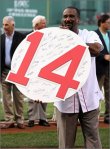 nly couldn’t hurt. After all, in such a historic venue as Fenway Park with such a history laden team as the Boston Americans not everything in view needs to be an advertisement.
nly couldn’t hurt. After all, in such a historic venue as Fenway Park with such a history laden team as the Boston Americans not everything in view needs to be an advertisement.
For players whose numbers are being honored, place their number in road uniform coordinated navy blue and gray as opposed to the retired number coordination of the home red and white. Equally coordinated would be the player’s name, in road font, above the number but equally placed on the border of the gray circle. Should be fairly simple, right?
For players who didn’t wear a number and are being honored, find an equally coordinated way to either place their name in the gray circle or maybe just place them on a higher section of the wall displaying the honored numbers (I recommend the right field bleachers). They do something similar at Comerica Park in Detroit.
I know there will be at least one controversial pick….
James “Jimmie” Foxx, was the second major league player to hit 500 career home runs, after Babe Ruth. Attaining that plateau at age 32 years 336 days, he held the record for youngest to reach 500 for sixty-eight years, until superseded by Alex Rodriguez in 2007. His three career Most Valu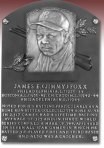 able Player awards are tied for second all-time. ‘Double X’ played six years for Boston, including a spectacular 1938 season in which he hit 50 home runs, drove in 175 runs, batted .349, won his third MVP award, and again narrowly missed winning the Triple Crown. Foxx is one of nine players to have won three MVPs; only Barry Bonds (7) has more. On June 16, 1938, he set an American League record when he walked six times in a game. In 1939 he hit .360, his second-best all-time season batting average. His 50 home runs would remain the single-season record for the Red Sox until David Ortiz hit 54 in 2006. Jersey #3
able Player awards are tied for second all-time. ‘Double X’ played six years for Boston, including a spectacular 1938 season in which he hit 50 home runs, drove in 175 runs, batted .349, won his third MVP award, and again narrowly missed winning the Triple Crown. Foxx is one of nine players to have won three MVPs; only Barry Bonds (7) has more. On June 16, 1938, he set an American League record when he walked six times in a game. In 1939 he hit .360, his second-best all-time season batting average. His 50 home runs would remain the single-season record for the Red Sox until David Ortiz hit 54 in 2006. Jersey #3
Nomar Garciaparra is a six-time All-Star (1997, 1999, 2000, 2002, 2003, 2006). Garciaparra was originally drafted by the Milwaukee Brewers in the 5th round of the 1991 draft, but did not sign. Garciaparra was a first round pick of the Red Sox in 1994 following a successful career at Georgia Tech. He played in the Red Sox minor league system for three years (1994–Sarasota, 1995–Trenton, 1996–Pawtucket). He made his Major League debut on August 31, 1996, as a defensive replacement against Oakland. His first Major League hit was a home run off of Oakland pitcher John Wasdin on September 1. Nomar would then ultimately take Wasdin deep a record thirteen times over his career. Garciaparra is known for his idiosyncratic tics when batting. This habit includes an elaborate routine of glove adjustments and alternating toe taps on the ground prior to an ensuing pitch. At the time, Boston’s starting shortstop was John Valentin, who finished ninth in MVP voting in 1995. By late 1996, Nomar won the job. Garciaparra’s talent was enough to displace Valentin, who was moved to second base (then third base) to make room for young Garciaparra, who batted .241 with 4 home runs, 16 RBI, and 5 stolen bases in his initial stint with the club near the end of 1996. As a rookie in 1997, he hit 30 home runs and drove in 98 runs, setting a new MLB record for RBIs by a leadoff hitter and most homers by a rookie shortstop. His 30-game hitting streak set an A.L. rookie record. He was named Rookie of the Year in a unanimous vote, competed in the Home Run Derby, and finished eighth in MVP voting. He also won the immediate admiration of Red Sox fans, who referred to him in Boston accents as “NO-mah!”. His popularity in New England was reflected in the Saturday Night Live “The Boston Teens” sketches, where Jimmy Fallon’s character Pat Sullivan always wore a Garciaparra T-shirt and would repeatedly reference his admiration for him. Garciaparra even appeared in one of the sketches, where he was introduced as the boyfriend of Sully’s sister (played by guest host Kate Hudson). He finished with 35 home runs and 122 RBI in 1998, and placed as the runner-up for AL MVP. Garciaparra then led the American League in batting average for the next two years, hitting .357 in 1999 and .372 in 2000, finishing in the top ten in MVP voting both years. He is one of the few right-handed batters to win consecutive batting titles, and the first since Joe DiMaggio. He hit safely and scored a run in the first five games of his post-season career (1998–99), and is joined by Ian Kinsler (2010) as the only other player to start his post-season career in that manner.
 In February of 2001, Garciaparra appeared on the cover of Sports Illustrated, with the headline “A Cut Above… baseball’s toughest out”. The week after the issue hit newsstands, Garciaparra suffered a broken right wrist that would ruin his season and alter the trajectory of his career. He recovered by the start of the 2002 season and drove in 120 runs while hitting a league-leading 56 doubles. However, he had a difficult time playing as strongly defensively as before, and his batting average dipped substantially, though it was still an excellent .310. Before the 2002 season, a new ownership group purchased the Red Sox. The baseball operations staff, led by Theo Epstein, stressed on-base percentage on offense and strong defense, two areas where Garciaparra was about to decline precipitously from his pre-2001 levels. Still, Garciaparra recovered from an injury-filled 2001 season to bat .310 with 24 home runs and 120 RBIs in 2002. The star shortstop was up for a contract extension following the 2004 season and hoped for a deal before that deadline. Still considered one of the best shortstops in baseball, he hoped to receive salaries similar to peers Alex Rodriguez and Derek Jeter. In 2003, Garciaparra had a good season in which he was second in the majors in triples, fifth in the AL in hits, and second in the AL in runs scored. Unfortunately, a September slump caused his batting average to dip, but it still ended at a very good .301. He followed that with a poor post-season, contributing zero home runs, one RBI and ten strikeouts in 12 games against the Oakland Athletics and rival Yankees, who eliminated the Red Sox in a thrilling seven-game series. Meanwhile, new stars and cult heroes, led by David Ortiz and Kevin Millar, began to emerge in Boston. Millar convinced nearly every player on the roster other than Johnny Damon and Garciaparra (whose wedding with Mia Hamm followed the season) to shave his head.
In February of 2001, Garciaparra appeared on the cover of Sports Illustrated, with the headline “A Cut Above… baseball’s toughest out”. The week after the issue hit newsstands, Garciaparra suffered a broken right wrist that would ruin his season and alter the trajectory of his career. He recovered by the start of the 2002 season and drove in 120 runs while hitting a league-leading 56 doubles. However, he had a difficult time playing as strongly defensively as before, and his batting average dipped substantially, though it was still an excellent .310. Before the 2002 season, a new ownership group purchased the Red Sox. The baseball operations staff, led by Theo Epstein, stressed on-base percentage on offense and strong defense, two areas where Garciaparra was about to decline precipitously from his pre-2001 levels. Still, Garciaparra recovered from an injury-filled 2001 season to bat .310 with 24 home runs and 120 RBIs in 2002. The star shortstop was up for a contract extension following the 2004 season and hoped for a deal before that deadline. Still considered one of the best shortstops in baseball, he hoped to receive salaries similar to peers Alex Rodriguez and Derek Jeter. In 2003, Garciaparra had a good season in which he was second in the majors in triples, fifth in the AL in hits, and second in the AL in runs scored. Unfortunately, a September slump caused his batting average to dip, but it still ended at a very good .301. He followed that with a poor post-season, contributing zero home runs, one RBI and ten strikeouts in 12 games against the Oakland Athletics and rival Yankees, who eliminated the Red Sox in a thrilling seven-game series. Meanwhile, new stars and cult heroes, led by David Ortiz and Kevin Millar, began to emerge in Boston. Millar convinced nearly every player on the roster other than Johnny Damon and Garciaparra (whose wedding with Mia Hamm followed the season) to shave his head.
After the 2003 season, Red Sox management explored trading Manny Ramírez to the Texas Rangers for shortstop Alex Rodriguez. However, the MLB Players’ Union objected to Rodriguez’s willingness to sacrifice a huge amount of his $250 million contract to facilitate a deal to Boston, and the New York Yankees then struck a deal with Texas to bring A-Rod (who gave up $14 million with union approval) to their team. The Red Sox then had covert trade talks i nvolving Nomar with the Chicago White Sox, but the subsequent agreement to trade Garciapara and others for a package centered around Magglio Ordóñez quickly became public. Garciaparra thus returned to Boston for the start of the 2004 season in the final year of a contract signed in 1997, and it quickly became clear that he was enraged with the team and would not return to Boston after the season. On July 31, 2004 (the MLB trading deadline), Garciaparra was the key player involved in a four-team deal that sent Nomar and Matt Murton to the wild card leading Chicago Cubs. The Red Sox received Orlando Cabrera and Doug Mientkiewicz. Nomar expressed his appreciation to Red Sox fans in a speech to the media, and left for the Windy City. At first, Garciaparra was assigned jersey number 8, because Cub catcher Michael Barrett wore number 5. A few days later, they switched numbers. On March 10, 2010, Garciaparra signed a one-day contract with the Boston Red Sox to retire as a member of the organization. On May 5, 2010, The Red Sox hosted “Nomar Garciaparra Night”, honoring Nomar before a game against the Los Angeles Angels of Anaheim. He was given two official seats from Fenway by Johnny Pesky, one bearing Nomar’s own #5, and the other bearing Pesky’s #6.
nvolving Nomar with the Chicago White Sox, but the subsequent agreement to trade Garciapara and others for a package centered around Magglio Ordóñez quickly became public. Garciaparra thus returned to Boston for the start of the 2004 season in the final year of a contract signed in 1997, and it quickly became clear that he was enraged with the team and would not return to Boston after the season. On July 31, 2004 (the MLB trading deadline), Garciaparra was the key player involved in a four-team deal that sent Nomar and Matt Murton to the wild card leading Chicago Cubs. The Red Sox received Orlando Cabrera and Doug Mientkiewicz. Nomar expressed his appreciation to Red Sox fans in a speech to the media, and left for the Windy City. At first, Garciaparra was assigned jersey number 8, because Cub catcher Michael Barrett wore number 5. A few days later, they switched numbers. On March 10, 2010, Garciaparra signed a one-day contract with the Boston Red Sox to retire as a member of the organization. On May 5, 2010, The Red Sox hosted “Nomar Garciaparra Night”, honoring Nomar before a game against the Los Angeles Angels of Anaheim. He was given two official seats from Fenway by Johnny Pesky, one bearing Nomar’s own #5, and the other bearing Pesky’s #6.
 Dominic DiMaggio, nicknamed “The Little Professor”, played his entire 11-year baseball career for the Boston Red Sox (1940–1953). He was the youngest of three brothers who each became major league center fielders, the others being Joe and Vince. An effective leadoff hitter, he batted .300 four times and led the American League in runs twice and in triples and stolen bases once each. He also led the AL in assists three times and in putouts and double plays twice each; he tied a league record by recording 400 putouts four times, and his 1948 totals of 503 putouts and 526 total chances stood as AL records for nearly thirty years. His 1338 games in center field ranked eighth in AL history when he retired. His 34-game hitting streak in 1949 remains a Boston club record. 7× All-Star selection (1941, 1942, 1946, 1949, 1950, 1951, 1952) Jersey #7
Dominic DiMaggio, nicknamed “The Little Professor”, played his entire 11-year baseball career for the Boston Red Sox (1940–1953). He was the youngest of three brothers who each became major league center fielders, the others being Joe and Vince. An effective leadoff hitter, he batted .300 four times and led the American League in runs twice and in triples and stolen bases once each. He also led the AL in assists three times and in putouts and double plays twice each; he tied a league record by recording 400 putouts four times, and his 1948 totals of 503 putouts and 526 total chances stood as AL records for nearly thirty years. His 1338 games in center field ranked eighth in AL history when he retired. His 34-game hitting streak in 1949 remains a Boston club record. 7× All-Star selection (1941, 1942, 1946, 1949, 1950, 1951, 1952) Jersey #7
 Roger Clemens nicknamed “Rocket”, broke into the league with the Boston Red Sox whose pitching staff he would help anchor for 12 years. Clemens was drafted 19th overall by the Boston Red Sox in 1983 and quickly rose through the minor league system, making his major league debut on May 15, 1984. In 1986, his 24 wins helped guide the Sox to a World Series berth and earned Clemens the American League MVP award for the regular season. He also won the first of his seven Cy Young Awards. Hall of Fame slugger Hank Aaron angered the pitcher by saying that pitchers should not be eligible for the MVP. “I wish he were still playing,” Clemens responded. “I’d probably crack his head open to show him how valuable I was.” Clemens remains the only starting pitcher since Vida Blue in 1971 to win a league MVP award. On April 29, 1986, Clemens became the first pitcher in history to strike out 20 batters in a nine-inning major league game, against the Seattle Mariners at Fenway Park. Only Kerry Wood and Randy Johnson have matched the total. Clemens attributes his switch from what he calls a “thrower” to a “pitcher” to the partial season Hall of Fame pitcher Tom Seaver spent with the Red Sox in 1986. Clemens accomplished the 20-strikeout feat twice, the only player ever to do so. The second performance came more than 10 years later, on September 18, 1996 against the Detroit Tigers at Tiger Stadium. Clemens’ second 20-K day occurred in his third-to-last regular season game as a member of the Boston Red Sox. Clemens recorded 192 wins for the Red Sox, tied with Cy Young for the franchise record.
Roger Clemens nicknamed “Rocket”, broke into the league with the Boston Red Sox whose pitching staff he would help anchor for 12 years. Clemens was drafted 19th overall by the Boston Red Sox in 1983 and quickly rose through the minor league system, making his major league debut on May 15, 1984. In 1986, his 24 wins helped guide the Sox to a World Series berth and earned Clemens the American League MVP award for the regular season. He also won the first of his seven Cy Young Awards. Hall of Fame slugger Hank Aaron angered the pitcher by saying that pitchers should not be eligible for the MVP. “I wish he were still playing,” Clemens responded. “I’d probably crack his head open to show him how valuable I was.” Clemens remains the only starting pitcher since Vida Blue in 1971 to win a league MVP award. On April 29, 1986, Clemens became the first pitcher in history to strike out 20 batters in a nine-inning major league game, against the Seattle Mariners at Fenway Park. Only Kerry Wood and Randy Johnson have matched the total. Clemens attributes his switch from what he calls a “thrower” to a “pitcher” to the partial season Hall of Fame pitcher Tom Seaver spent with the Red Sox in 1986. Clemens accomplished the 20-strikeout feat twice, the only player ever to do so. The second performance came more than 10 years later, on September 18, 1996 against the Detroit Tigers at Tiger Stadium. Clemens’ second 20-K day occurred in his third-to-last regular season game as a member of the Boston Red Sox. Clemens recorded 192 wins for the Red Sox, tied with Cy Young for the franchise record.
No Red Sox player has worn his #21 since Clemens left the team in 1996.
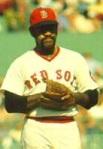 Luis Tiant. The Braves signed him to a minor league contract to play with their Triple-A Richmond, where he pitched well, and was acquired by the Louisville Colonels, a farm team of the Boston Red Sox. He was quickly called back up to the majors, and despite struggling through 1971 with a 1-7 record and 4.88 ERA, he would soon become one of the greatest and most beloved pitchers in Red Sox history and a great idol in Boston. Starting to be known as El Tiante at Fenway Park, in 1972 Tiant regained his old form with a 15-6 record and led the league with a 1.91 ERA. He would win 20 games in 1973 and 22 in 1974. Though hampered by back problems in 1975, he won 18 games for the American League Champion Red Sox and then excelled for Boston in the postseason. In the playoffs he defeated the three-time defending World Champion Oakland Athletics in a 7-1 three-hitter complete game, then opened the World Series against the Cincinnati Reds. His father and mother, having been allowed to visit from Cuba under a special visa, were in Fenway Park that game to watch their son defeat The Big Red Machine in a 6-0 five-hit shutout. All six Red Sox runs were scored in the seventh inning; Tiant led off that inning (the designated hitter was not yet in use in World Series play) with a base hit off Don Gullett and eventually scored on Carl Yastrzemski’s single for the first of those six runs. Tiant won Game 4 as well (throwing 163 pitches in his second complete game in the series) and had a no-decision in Game 6, which has been called the greatest game ever played, after Carlton Fisk’s dramatic game-winning walk-off home run in the 12th inning. Tiant went 21-12 in 1976, 12-8 in 1977, and 13-8 in 1978. Tiant is only 1 of 5 pitchers to have pitched four or more straight shutouts in the 50-year expansion era, with Don Drysdale (six, 1968), Bob Gibson (five, 1968), Orel Hershiser (five, 1988) and Gaylord Perry (four, 1970) being the others. He was inducted to the Boston Red Sox Hall of Fame in 1997. Jersey # 23
Luis Tiant. The Braves signed him to a minor league contract to play with their Triple-A Richmond, where he pitched well, and was acquired by the Louisville Colonels, a farm team of the Boston Red Sox. He was quickly called back up to the majors, and despite struggling through 1971 with a 1-7 record and 4.88 ERA, he would soon become one of the greatest and most beloved pitchers in Red Sox history and a great idol in Boston. Starting to be known as El Tiante at Fenway Park, in 1972 Tiant regained his old form with a 15-6 record and led the league with a 1.91 ERA. He would win 20 games in 1973 and 22 in 1974. Though hampered by back problems in 1975, he won 18 games for the American League Champion Red Sox and then excelled for Boston in the postseason. In the playoffs he defeated the three-time defending World Champion Oakland Athletics in a 7-1 three-hitter complete game, then opened the World Series against the Cincinnati Reds. His father and mother, having been allowed to visit from Cuba under a special visa, were in Fenway Park that game to watch their son defeat The Big Red Machine in a 6-0 five-hit shutout. All six Red Sox runs were scored in the seventh inning; Tiant led off that inning (the designated hitter was not yet in use in World Series play) with a base hit off Don Gullett and eventually scored on Carl Yastrzemski’s single for the first of those six runs. Tiant won Game 4 as well (throwing 163 pitches in his second complete game in the series) and had a no-decision in Game 6, which has been called the greatest game ever played, after Carlton Fisk’s dramatic game-winning walk-off home run in the 12th inning. Tiant went 21-12 in 1976, 12-8 in 1977, and 13-8 in 1978. Tiant is only 1 of 5 pitchers to have pitched four or more straight shutouts in the 50-year expansion era, with Don Drysdale (six, 1968), Bob Gibson (five, 1968), Orel Hershiser (five, 1988) and Gaylord Perry (four, 1970) being the others. He was inducted to the Boston Red Sox Hall of Fame in 1997. Jersey # 23
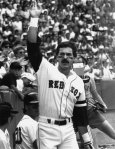 Dwight Evans nicknamed “Dewey”, started his career by winning International League MVP honors, but in his early major league career, he was primarily a defensive standout with a modest bat. In the second half of his career, he became a powerful batter. Evans made his Major League Baseball debut for the Boston Red Sox on September 16, 1972 in a game against the Cleveland Indians. The Red Sox won 10-0 behind the pitching of Luis Tiant who threw a 3-hit complete game. Evans pinch ran for Reggie Smith in the 6th but was stranded at 2B, he played in right field where he recorded 1 PO. Evans went 0-1 at the plate in his debut. Evans played in 18 games in 1972 for the Red Sox, and had 57 plate appearances (.263 BA, 15 H, 2 R, 6 RBI, 1 HR). Despite the strike-shortened 1981 season, Evans had his best all-around year. He paced the league in total bases (215), OPS (.937), walks (85), times on base (208), and tied Eddie Murray, Tony Armas and Bobby Grich for the home run title with 22. He also ranked second in runs scored (84) and on-base percentage (.415), and third in slugging percentage (.522). He added a .296 batting average with 71 runs batted in. In 1987, at age 35, Evans recorded career highs in batting average (.305), HRs (34) and RBI (123).
Dwight Evans nicknamed “Dewey”, started his career by winning International League MVP honors, but in his early major league career, he was primarily a defensive standout with a modest bat. In the second half of his career, he became a powerful batter. Evans made his Major League Baseball debut for the Boston Red Sox on September 16, 1972 in a game against the Cleveland Indians. The Red Sox won 10-0 behind the pitching of Luis Tiant who threw a 3-hit complete game. Evans pinch ran for Reggie Smith in the 6th but was stranded at 2B, he played in right field where he recorded 1 PO. Evans went 0-1 at the plate in his debut. Evans played in 18 games in 1972 for the Red Sox, and had 57 plate appearances (.263 BA, 15 H, 2 R, 6 RBI, 1 HR). Despite the strike-shortened 1981 season, Evans had his best all-around year. He paced the league in total bases (215), OPS (.937), walks (85), times on base (208), and tied Eddie Murray, Tony Armas and Bobby Grich for the home run title with 22. He also ranked second in runs scored (84) and on-base percentage (.415), and third in slugging percentage (.522). He added a .296 batting average with 71 runs batted in. In 1987, at age 35, Evans recorded career highs in batting average (.305), HRs (34) and RBI (123).
Evans was named an Outfielder on The Sporting News AL All-Star team in 1982, 1984 and 1987 and was also tabbed as an Outfielder on the AL Silver Slugger Team by The Sporting News in 1981 and 1987. Evans would win the Gold Glove award in 1976, 1978, 1979, 1981, 1982, 1983, 1984, and 1985. In his 20-year career, Evans batted .272, with 385 home runs, 1384 RBI, 1470 runs, 2446 hits, 483 doubles, 73 triples, and 78 stolen bases in 2606 games. Only Carl Yastrzemski (3308) played more games for the Red Sox than Evans (2505). From 1980 through 1989, Evans hit more home runs (256) than any other player in the American League. He also led the A.L. in extra base hits over the same period of time. He is the only player to hit 20 or more home runs during every season of the 80’s (1980–1989). Evans hit a home run four times on Opening Day. On April 7, 1986, he set a major league record by hitting the first pitch of the season for a home run, eclipsing the mark held by the Chicago Cubs’ Bump Wills, who hit the second pitch for a home run on April 4, 1982. He spent his final season with the Orioles, batting .270 with six homers and drove in 38 runs in 101 games. In 2000, Dwight Evans was selected to the Boston Red Sox Hall of Fame.
Originally Evans was assigned the uniform number 40 but quietly he wanted to wear number 24, the number of his idol Willie Mays. In 1973 Sox gave him number 24, the number he wore for the rest of his career in Boston and one year with Baltimore. Other Red Sox players to wear the same jersey number since Evans retired include Kevin Mitchell, Mike Stanley, Manny Ramírez, and Takashi Saito.
 Wade Boggs hitting in the 1980s and 1990s made him a perennial contender for American League batting titles. Boggs was elected to the Red Sox Hall of Fame in 2004 and the Baseball Hall of Fame in 2005. With 12 straight All-Star appearances, Boggs is third only to Brooks Robinson and George Brett in number of consecutive appearances as a third baseman. His finest season was 1987, when he set career highs in home runs (24), RBI (89), and slugging percentage (.588). He also batted .363 and had a .461 on-base percentage that year, leading the league in both statistics. In 1999, he ranked number 95 on the Sporting News list of the 100 Greatest Baseball Players, and was a nominee for the Major League Baseball All-Century Team. A left-handed hitter, Boggs won five batting titles starting in 1983. He also batted .349 in his rookie year which would have won the batting title, but was 121 plate appearances short of the required minimum of 502. From 1982 to 1988, Boggs hit below .349 only once, hitting .325 in 1984. From 1983 t
Wade Boggs hitting in the 1980s and 1990s made him a perennial contender for American League batting titles. Boggs was elected to the Red Sox Hall of Fame in 2004 and the Baseball Hall of Fame in 2005. With 12 straight All-Star appearances, Boggs is third only to Brooks Robinson and George Brett in number of consecutive appearances as a third baseman. His finest season was 1987, when he set career highs in home runs (24), RBI (89), and slugging percentage (.588). He also batted .363 and had a .461 on-base percentage that year, leading the league in both statistics. In 1999, he ranked number 95 on the Sporting News list of the 100 Greatest Baseball Players, and was a nominee for the Major League Baseball All-Century Team. A left-handed hitter, Boggs won five batting titles starting in 1983. He also batted .349 in his rookie year which would have won the batting title, but was 121 plate appearances short of the required minimum of 502. From 1982 to 1988, Boggs hit below .349 only once, hitting .325 in 1984. From 1983 t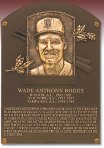 o 1989, Boggs rattled off seven consecutive seasons in which he collected 200 or more hits, an American League record for consecutive 200-hit seasons that was later matched and surpassed by Seattle’s Ichiro Suzuki. Boggs also had six seasons with 200 or more hits, 100+ runs and 40+ doubles. Although he would not win another batting title after 1988 (his batting title that year broke Bill Madlock’s Major League record of four by a third baseman), he regularly appeared among the league leaders in hitting.
o 1989, Boggs rattled off seven consecutive seasons in which he collected 200 or more hits, an American League record for consecutive 200-hit seasons that was later matched and surpassed by Seattle’s Ichiro Suzuki. Boggs also had six seasons with 200 or more hits, 100+ runs and 40+ doubles. Although he would not win another batting title after 1988 (his batting title that year broke Bill Madlock’s Major League record of four by a third baseman), he regularly appeared among the league leaders in hitting.
In 1986, Boggs made it to the World Series with the Red Sox, but they lost to the New York Mets in seven games. The photo of him fighting back tears, taken by George Kalinsky, photographer for the Mets, emblemized the emotions of many Red Sox fans after their team’s loss at Shea Stadium. Jersey # 26
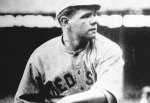 George Herman Ruth, Jr., best known as “Babe” Ruth and nicknamed “the Bambino” and “the Sultan of Swat“, originally broke into the major leagues with the Boston Red Sox as a starting pitcher, but after he was sold to the New York Yankees in 1919, he converted to a full-time right fielder and subsequently became one of the league’s most prolific hitters. After a short stint with the Boston Braves in 1935, Ruth retired. In 1936, Ruth became one of the first five players elected to the Baseball Hall of Fame.
George Herman Ruth, Jr., best known as “Babe” Ruth and nicknamed “the Bambino” and “the Sultan of Swat“, originally broke into the major leagues with the Boston Red Sox as a starting pitcher, but after he was sold to the New York Yankees in 1919, he converted to a full-time right fielder and subsequently became one of the league’s most prolific hitters. After a short stint with the Boston Braves in 1935, Ruth retired. In 1936, Ruth became one of the first five players elected to the Baseball Hall of Fame.
Ruth appeared in five games for the Red Sox in 1914, pitching in four of them. He picked up the victory in his major league debut on July 11. The Red Sox had many star players in 1914, so Ruth was soon optioned to the minor league Providence Grays of Providence, Rhode Island for most of the remaining season. Behind Ruth and Carl Mays, the Grays won the International League pennant. During spring training in 1915, Ruth secured a spot in the Red Sox starting rotation. He joined a pitching staff that included Rube Foster, Dutch Leonard, and Smokey Joe Wood. Ruth won 18 games, lost eight, and helped himself by hitting .315. He also hit his first four home runs. The Red Sox won 101 games that year on their way to a victory in the World Series. Ruth did not pitch in the series, and grounded out in his only at-bat. In 1916, after a slightly shaky spring, he went 23–12, with a 1.75 ERA and nine shutouts, both of which led the league. On June 27, he struck out ten Philadelphia A’s, a career high. On July 11, he started both games of a doubleheader, but the feat was not what it seemed; he only pitched one-third of an inning in the opener because the scheduled starter, Foster, had trouble getting loose. Ruth then pitched a complete-game victory in the nightcap. Ruth had unusual success against Washington Senators star pitcher Walter Johnson, beating him four times in 1916 alone, by scores of 5–1, 1–0, 1–0 in 13 innings, and 2–1. Johnson finally outlasted Ruth for an extra-inning 4–3 victory on September 12; in the years to come, Ruth would hit ten home runs off Johnson, including the only two Johnson would allow in 1918–1919. Ruth’s nine shutouts in 1916 set an AL record for left-handers which would remain unmatched until Ron Guidry tied it in 1978. Despite a weak offense, hurt by the sale of Tris Speaker to the Indians, the Red Sox made it to the World Series. They defeated the Brooklyn Robins four games to one. This time Ruth made a major contribution, pitching a 14-inning complete-game victory in Game Two.
In the years 1915–1917, Ruth had been used in just 44 games in which he had not pitched. After the 1917 season, in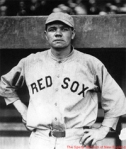 which he hit .325, albeit with limited at bats, teammate Harry Hooper suggested that Ruth might be more valuable in the lineup as an everyday player. In 1918, he began playing in the outfield more and pitching less, making 75 hitting-only appearances. Former teammate Tris Speaker speculated that the move would shorten Ruth’s career, though Ruth himself wanted to hit more and pitch less. In 1918, Ruth batted .300 and led the A.L. in home runs with eleven despite having only 317 at-bats, well below the total for an everyday player. During the 1919 season, Ruth pitched in only 17 of his 130 games. He also set his first single-season home run record that year with 29 (passing Ned Williamson’s 27 in 1884), including a game-winning homer on a September “Babe Ruth Day” promotion. It was Babe Ruth’s last season with the Red Sox.
which he hit .325, albeit with limited at bats, teammate Harry Hooper suggested that Ruth might be more valuable in the lineup as an everyday player. In 1918, he began playing in the outfield more and pitching less, making 75 hitting-only appearances. Former teammate Tris Speaker speculated that the move would shorten Ruth’s career, though Ruth himself wanted to hit more and pitch less. In 1918, Ruth batted .300 and led the A.L. in home runs with eleven despite having only 317 at-bats, well below the total for an everyday player. During the 1919 season, Ruth pitched in only 17 of his 130 games. He also set his first single-season home run record that year with 29 (passing Ned Williamson’s 27 in 1884), including a game-winning homer on a September “Babe Ruth Day” promotion. It was Babe Ruth’s last season with the Red Sox.
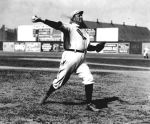 Denton True “Cy” Young, joined the American League’s Boston Americans in 1901 for a $3,500 contract ($92,092 in current dollar terms). Young would remain with the Boston team until 1909. In his first year in the American League, Young was dominant. Young led the league in wins, strikeouts, and ERA, thus earning the colloquial AL Triple Crown for pitchers. Young won almost 42% of his team’s games in 1901, accounting for 33 of his team’s 79 wins. In February 1902, before the start of the baseball season, Young served as a pitching coach at Harvard University. The sixth-grade graduate instructing Harvard students delighted Boston newspapers. The Boston Americans played the Pittsburgh Pirates in the first modern World Series in 1903. Young, who started Game One against the visiting Pirates, thus threw the first pitch in modern World Series history. The Pirates scored four runs in that first inning, and Young lost the game. Young performed better in subsequent games, winning his next two starts. He also drove in three runs in Game Five. Young finished the series with a 2–1 record and a 1.85 ERA in four appearances, and Boston defeated Pittsburgh, five games to three games.
Denton True “Cy” Young, joined the American League’s Boston Americans in 1901 for a $3,500 contract ($92,092 in current dollar terms). Young would remain with the Boston team until 1909. In his first year in the American League, Young was dominant. Young led the league in wins, strikeouts, and ERA, thus earning the colloquial AL Triple Crown for pitchers. Young won almost 42% of his team’s games in 1901, accounting for 33 of his team’s 79 wins. In February 1902, before the start of the baseball season, Young served as a pitching coach at Harvard University. The sixth-grade graduate instructing Harvard students delighted Boston newspapers. The Boston Americans played the Pittsburgh Pirates in the first modern World Series in 1903. Young, who started Game One against the visiting Pirates, thus threw the first pitch in modern World Series history. The Pirates scored four runs in that first inning, and Young lost the game. Young performed better in subsequent games, winning his next two starts. He also drove in three runs in Game Five. Young finished the series with a 2–1 record and a 1.85 ERA in four appearances, and Boston defeated Pittsburgh, five games to three games.
After one-hitting Boston on May 2, 1904, Philadelphia Athletics pitcher Rube Waddell taunted Young to face him so that he could repeat his performance against Boston’s ace. Three days later, Young pitched a perfect game against Waddell and the Athletics. It was the first perfect game in American League history. Waddell was the 27th and last batter, and when he flied out, Young shouted, “How do you like that, you hayseed?” Waddell had picked an inauspicious time to issue his challenge. Young’s perfect game was the centerpiece of a pitching streak. Young set major league records for the most consecutive scoreless innings pitched and the most consecutive innings without allowing a hit; the latter record still stands at 24.1 innings, or 73 hitless batters. Even after allowing a hit, Young’s scoreless streak reached a then-record 45 shutout innings. Before Young, only two pitchers had thrown perfect games. Young’s perfect game was the first under the modern rules established in 1893. One year later, on July 4, 1905, Rube Waddell beat Young and the Americans, 4–2, in a 20-inning matchup. Young pitched 13 consecutive scoreless innings before he gave up a pair of unearned runs in the final inning. Young did not walk a batter and was later quoted: “For my part, I think it was the greatest game of ball I ever took part i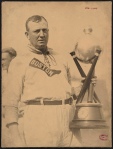 n.” In 1907, Young and Waddell faced off in a scoreless 13-inning tie. In 1908, Young pitched the third no-hitter of his career. Three months past his 41st birthday, Cy Young was the oldest pitcher to record a no-hitter, a record which would stand 82 years until 43-year-old Nolan Ryan surpassed the feat. Only a walk kept Young from his second perfect game. After that runner was caught stealing, no other batter reached base. At this time, Young was the second-oldest player in either league. In another game one month before his no-hitter, he allowed just one single while facing 28 batters. On August 13, 1908, the league celebrated “Cy Young Day.” No American League games were played on that day, and a group of All-Stars from the league’s other teams gathered in Boston to play against Young and the Red Sox.
n.” In 1907, Young and Waddell faced off in a scoreless 13-inning tie. In 1908, Young pitched the third no-hitter of his career. Three months past his 41st birthday, Cy Young was the oldest pitcher to record a no-hitter, a record which would stand 82 years until 43-year-old Nolan Ryan surpassed the feat. Only a walk kept Young from his second perfect game. After that runner was caught stealing, no other batter reached base. At this time, Young was the second-oldest player in either league. In another game one month before his no-hitter, he allowed just one single while facing 28 batters. On August 13, 1908, the league celebrated “Cy Young Day.” No American League games were played on that day, and a group of All-Stars from the league’s other teams gathered in Boston to play against Young and the Red Sox.
In 1956, about one year after Young’s death, the Cy Young Award was created. Originally, it was a single award covering the whole of baseball. The honor was divided into two Cy Young Awards in 1967, one for each league.
On September 23, 1993, a statue dedicated to him was unveiled by Northeastern University on the site of the Red Sox’s original stadium, the Huntington Avenue Grounds. It was there that Young had pitched the first game of the 1903 World Series, as well as the first perfect game in the modern era of baseball. A home plate-shaped plaque next to the statue reads:
“On October 1, 1903 the first modern World Series between the American League champion Boston Pilgrims (later known as the Red Sox) and the National League champion Pittsburgh Pirates was played on this site. General admission tickets were fifty cents. The Pilgrims, led by twenty-eight game winner Cy Young, trailed the series three games to one but then swept four consecutive victories to win the championship five games to three.”
Retired Numbers
This was a post from some time ago.. but I still feel it’s rather an important perspective from a member of ‘The Nation’.
Let’s take a break from the heavy lifting today and cover something we all care about…. Red Sox retired numbers.
Now as we all know (unless you’re a caveman living under a rock.. no wait, they have car insurance so no excuses) the Sox finally retired Jim Ed’s #14. The number had not been worn since he took it off in 1989 (except by himself during the coaching days) but couldn’t be raised to ‘Retired Row’ because h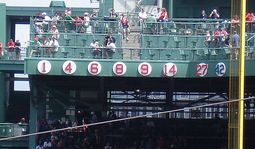 e hadn’t been inducted into the Hall of Fame. Yet Johnny Pesky had his number retired last year and did not meet such criteria.
e hadn’t been inducted into the Hall of Fame. Yet Johnny Pesky had his number retired last year and did not meet such criteria.
Stop!
I’m not even going to go down that long and winding slippery slope of saying “Pesky doesn’t deserve it” or “Why is his there?” or anything like it. Pesky’s #6 belongs there all day long, which brings me to my point…. so do a few others!
Pesky’s number was worn by a few guys to say the least before being retired but not in this century that I can recall. Buckner (1st term of service), Tony Pena and Damon Berryhill to name a few wore it. Pesky didn’t play 10 seasons with the Sox, retire a Red Sox or be elected to the Hall and still deserved the honor for his 60+ years of service to the hometown team. Maybe we should consider a way to ‘honor’ a number without retiring it…?
Try this. 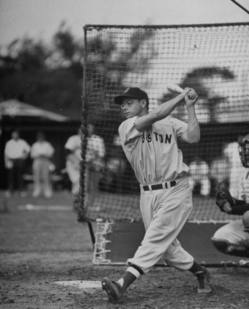 Let’s use Dom DiMaggio and Dwight Evans for example (everyone will have a candidate, I’m sure… Boggs, Clemens, Tiant, Tony C., and dozens more). Dom wore the number 7 which has most recently been worn by Christopher “Home Run Trot” Nixon and J.D. Drew. If we put his number up, do we take it from Drew in some Ray Bourque to Espo notion? No… high numbers in baseball look weak because of the prospect or minor league call up stigma. Even if you are J.T. Snow wearing dad’s Patriots’ number.
Let’s use Dom DiMaggio and Dwight Evans for example (everyone will have a candidate, I’m sure… Boggs, Clemens, Tiant, Tony C., and dozens more). Dom wore the number 7 which has most recently been worn by Christopher “Home Run Trot” Nixon and J.D. Drew. If we put his number up, do we take it from Drew in some Ray Bourque to Espo notion? No… high numbers in baseball look weak because of the prospect or minor league call up stigma. Even if you are J.T. Snow wearing dad’s Patriots’ number.
The numbers on ‘Retired Row’ are fashioned after the Sox home jersey colors, so let’s take the ‘honored’ numbers (as compared to retired) and put them in the road colors. Same size, just make the rear circle gray and the number a dark navy. Perhaps even fashion a jersey styled name plate atop the number (made smaller to look proper) to remind everone of just who it is honoring or if honoring two great players who wore the number (Manny and Evans for sh!ts and giggles). Place the numbers on ‘Retired Row’, past Jackie’s 42 or find another spot to display them, perhaps the top of the right field bleachers wall, and the Bleacher Creature’s can place the strikeout K’s below them during a game.
This way we see the ‘honored’ #7 for Dom, who didn’t meet the retired number criteria as set by the Red Sox organization but you can still give him his due in Sox history 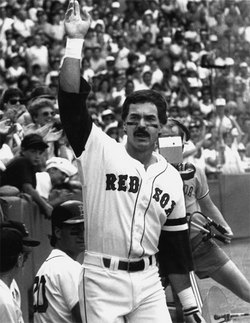 as a member of the ’46 team, a fantastic multi-time All-Star and all around teammate. Same for Dwight Evans. 24 is forever going to be linked to Manny Being Manny, but for nearly twenty years and two World Series (including his part in one of the greatest Series’ ever) it was Dewey’s. Put it up in road colors to ‘honor’ the player and his place in Sox history. Same for Jimmy Foxx, Wade Boggs and Luis Tiant… two HOF’s who had excellent runs with the Sox and one great personality who epitomized the team and the city if even for just a few short years. Just think, Wakefield probably won’t make it to the Hall, but we can still see his number resting proudly for generations to come, in his specific memory.
as a member of the ’46 team, a fantastic multi-time All-Star and all around teammate. Same for Dwight Evans. 24 is forever going to be linked to Manny Being Manny, but for nearly twenty years and two World Series (including his part in one of the greatest Series’ ever) it was Dewey’s. Put it up in road colors to ‘honor’ the player and his place in Sox history. Same for Jimmy Foxx, Wade Boggs and Luis Tiant… two HOF’s who had excellent runs with the Sox and one great personality who epitomized the team and the city if even for just a few short years. Just think, Wakefield probably won’t make it to the Hall, but we can still see his number resting proudly for generations to come, in his specific memory.
Now I know a lot of people like the Red Sox organizational criteria for having a number retired, it seper ates us from the Yankees who seem to have maybe three or four numbers under 20 available (with #2 definately out of service and #6 most likely for Torre) and a long storied history of monument park. Well, it’s like the Celtics people, when you are the penultimate dynasty in your sport who wins decade after decade, you have great players and recognize them. I’m not saying I agree with it, but the loyalty factor is undeniable. This way, we won’t take the numbers out of circulation and still give the ‘honored’ player his due. If it’s done with class, as is most everything the Sox do, it can be something very special. Special to the memories of the Fans. Special to memories of the Player. Special to the ongoing tradition of Red Sox Baseball.
ates us from the Yankees who seem to have maybe three or four numbers under 20 available (with #2 definately out of service and #6 most likely for Torre) and a long storied history of monument park. Well, it’s like the Celtics people, when you are the penultimate dynasty in your sport who wins decade after decade, you have great players and recognize them. I’m not saying I agree with it, but the loyalty factor is undeniable. This way, we won’t take the numbers out of circulation and still give the ‘honored’ player his due. If it’s done with class, as is most everything the Sox do, it can be something very special. Special to the memories of the Fans. Special to memories of the Player. Special to the ongoing tradition of Red Sox Baseball.
Retired Numbers
Let’s take a break from the heavy lifting today and cover something we all care about…. Red Sox retired numbers.
Now as we all know (unless you’re a caveman living under a rock.. no wait, they have car insurance so no excuses) the Sox finally retired Jim Ed’s #14. The number had not been worn since he took it off in 1989 (except by himself during the coaching days) but couldn’t be raised to ‘Retired Row’ because h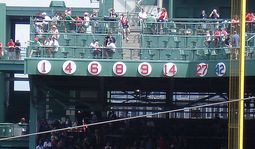 e hadn’t been inducted into the Hall of Fame. Yet Johnny Pesky had his number retired last year and did not meet such criteria.
e hadn’t been inducted into the Hall of Fame. Yet Johnny Pesky had his number retired last year and did not meet such criteria.
I’m not even going to go down that long and winding slippery slope of saying “Pesky doesn’t deserve it” or “Why is his there?” or anything like it. Pesky’s #6 belongs there all day long, which brings me to my point…. so do a few others!
Pesky’s number was worn by a few guys to say the least before being retired but not in this century that I can recall. Buckner (1st term of service), Tony Pena and Damon Berryhill to name a few wore it. Pesky didn’t play 10 seasons with the Sox, retire a Red Sox or be elected to the Hall and still deserved the honor for his 60+ years of service to the hometown team. Maybe we should consider a way to ‘honor’ a number without retiring it…?
Try this.  Let’s use Dom DiMaggio and Dwight Evans for example (everyone will have a candidate, I’m sure… Boggs, Clemens, Tiant, Tony C., and dozens more). Dom wore the number 7 which has most recently been worn by Christopher “Home Run Trot” Nixon and J.D. Drew. If we put his number up, do we take it from Drew in some Ray Bourque to Espo notion? No… high numbers in baseball look weak because of the prospect or minor league call up stigma. Even if you are J.T. Snow wearing dad’s Patriots’ number.
Let’s use Dom DiMaggio and Dwight Evans for example (everyone will have a candidate, I’m sure… Boggs, Clemens, Tiant, Tony C., and dozens more). Dom wore the number 7 which has most recently been worn by Christopher “Home Run Trot” Nixon and J.D. Drew. If we put his number up, do we take it from Drew in some Ray Bourque to Espo notion? No… high numbers in baseball look weak because of the prospect or minor league call up stigma. Even if you are J.T. Snow wearing dad’s Patriots’ number.
The numbers on ‘Retired Row’ are fashioned after the Sox home jersey colors, so let’s take the ‘honored’ numbers (as compared to retired) and put them in the road colors. Same size, just make the rear circle gray and the number a dark navy. Perhaps even fashion a jersey styled name plate atop the number (made smaller to look proper) to remind everone of just who it is honoring or if honoring two great players who wore the number (Manny and Evans for sh!ts and giggles). Place the numbers on ‘Retired Row’, past Jackie’s 42 or find another spot to display them, perhaps the top of the right field bleachers wall, and the Bleacher Creature’s can place the strikeout K’s below them during a game.
This way we see the ‘honored’ #7 for Dom, who didn’t meet the retired number criteria as set by the Red Sox organization but you can still give him his due in Sox history  as a member of the ’46 team, a fantastic multi-time All-Star and all around teammate. Same for Dwight Evans. 24 is forever going to be linked to Manny Being Manny, but for nearly twenty years and two World Series (including his part in one of the greatest Series’ ever) it was Dewey’s. Put it up in road colors to ‘honor’ the player and his place in Sox history. Same for Jimmy Foxx, Wade Boggs and Luis Tiant… two HOF’s who had excellent runs with the Sox and one great personality who epitomized the team and the city if even for just a few short years. Just think, Wakefield probably won’t make it to the Hall, but we can still see his number resting proudly for generations to come, in his specific memory.
as a member of the ’46 team, a fantastic multi-time All-Star and all around teammate. Same for Dwight Evans. 24 is forever going to be linked to Manny Being Manny, but for nearly twenty years and two World Series (including his part in one of the greatest Series’ ever) it was Dewey’s. Put it up in road colors to ‘honor’ the player and his place in Sox history. Same for Jimmy Foxx, Wade Boggs and Luis Tiant… two HOF’s who had excellent runs with the Sox and one great personality who epitomized the team and the city if even for just a few short years. Just think, Wakefield probably won’t make it to the Hall, but we can still see his number resting proudly for generations to come, in his specific memory.
Now I know a lot of people like the Red Sox organizational criteria for having a number retired, it seperates us from the Yankees who seem to have maybe three or four numbers under 20 available (with #2 definately out of service and #6 most likely for Torre) and a long storied history of monument park. Well, it’s like the Celtics people, when you are the penultimate dynasty in your sport who wins decade after decade, you have great players and recognize them. I’m not saying I agree with it, but the loyalty factor is undeniable. This way, we won’t take the numbers out of circulation and still give the ‘honored’ player his due. If it’s done with class, as is most everything the Sox do, it can be something very special. Special to the memories of the Fans. Special to memories of the Player. Special to the ongoing tradition of Red Sox Baseball.

